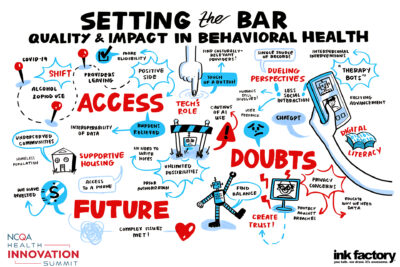Technology in Behavioral Health: Risks and Opportunities
October 23, 2025 · NCQA Communications
Thanks to everyone who attended this year’s Health Innovation Summit and made it a success! And if you couldn’t be there, keep reading for takeaways from the keynote session, Setting the Bar: Quality and Impact in Behavioral Health Innovation.
Moderator Geoffrey Neimark of Community Care Behavioral Health led a conversation with industry experts—Kate McEvoy of the National Association of Medicaid Directors and Michael Tang of Cityblock Health—about the risks and opportunities technology brings to behavioral health, especially for underserved populations.
Many factors contribute to the demand for behavioral health services: COVID pandemic isolation and social disconnection; overuse of alcohol, opioids and stimulants; the destigmatizing of behavioral conditions; increased behavioral health screening; the negative impact of social media. Unfortunately, the increase in demand coincides with a decrease in the number of practitioners.
“Behavioral health is primed to leverage technology to solve some of the access challenges,” says Neimark. “But there are also concerns about quality, equity and trust.”
Leveraging Technology in Behavioral Health
Telehealth is an effective way to improve access to behavioral health and substance use disorder care. Tang shared the story of a patient with schizophrenia who struggled to remember to take his pills every day and wanted to receive his medications through a shot. “I can supervise the patient virtually, even though I’m not in their home. Within minutes, I was on a virtual visit with him to assess his needs and discuss the medication,” says Tang.
McEvoy shared how Medicaid programs have embraced the use of technology to smooth the path to eligibility, improve access to services and supports through telehealth and enable better support and coordination of care for people with complex co-occurring needs.
“We recognize that different entities within state government—Medicaid, child welfare, departments of intellectual disability, the education system—all connect with children and families, but it’s been challenging to share data and coordinate efforts,” says McEvoy. “Interoperability can help identify needs and focus on those with the highest level of acuity.”
Risks of Using Technology and AI
Using AI with patients is a risk. “Many of our members come from minoritized communities and have distrust about new technologies. One of our core principles is that equity has to come first,” says Tang. “AI is part of care, but it’s not just AI by itself. It’s AI and humans working together to build trust and build relationships. We’re defining our AI governance processes and thinking cautiously about having AI work with our members.”
McEvoy also cautioned about the risk of relying too much on technology. “We’ve gone so far down the path with individualized home interventions, especially for older adults. We’re reexamining some programs to make sure we’re not contributing to social isolation, loneliness and depression.”
Technology and Health Literacy
While technology can provide many benefits, it’s not for everyone. Behavioral health organizations need to be thoughtful about how and where they implement technology, and consider limitations on broadband access or digital literacy.
“We’ve been surprised by the level of digital literacy of our members. People are texting and using their smartphones all the time,” says Tang. “But it is also situational. Sometimes our members can’t afford to pay their phone bill, so we need to be flexible and offer different ways for them to access services that are not technology dependent.”
Often, trust isn’t just about technology, it’s about the system itself. Having trusted messengers is also important. Community health workers or peer support specialists that share the same cultural background, speak the same language and have similar lived experience can build trust and, where appropriate, help facilitate the use of technology.
Evaluating the Use of Technology
Behavioral health organizations should consider these questions as they adopt new technologies:
- Who is the technology for—and who might it leave out?
- When is the technology solution appropriate—or inappropriate?
- Is the technology culturally responsive?
- Does the technology assume a certain level of digital literacy?
- How does the technology protect privacy and dignity?
“Technology cannot replace relationships. I’ve long been an advocate of group psychotherapy. It’s effective, it’s cost efficient, it amplifies access and it addresses social disconnection,” says Neimark. “I think we’re going to see a combination of growth in technology and growth in the human connection part of therapy.”
Join Us Next Year
Mark your calendar for the 2026 Health Innovation Summit, October 4–7, in Atlanta, Georgia. We hope to see you there!








